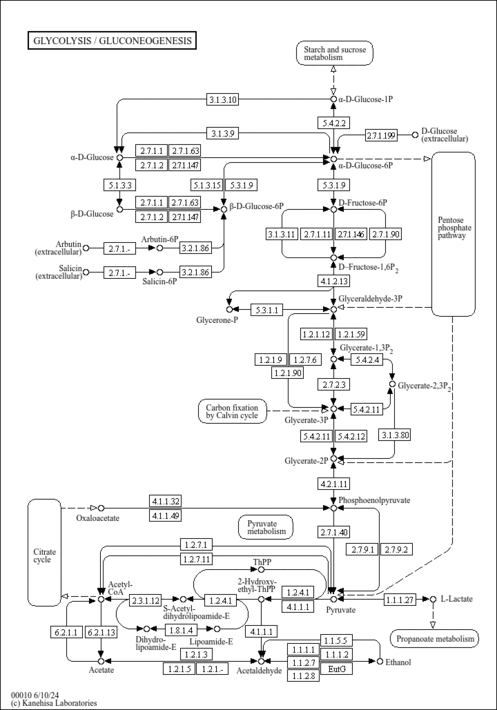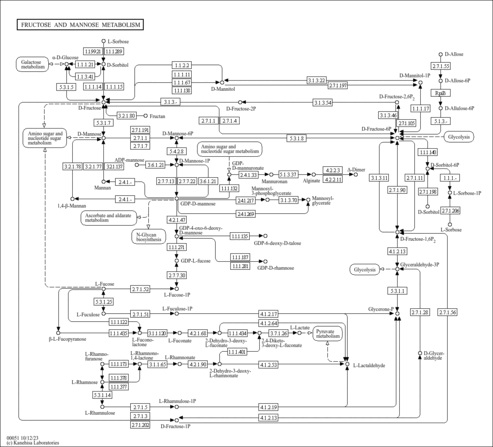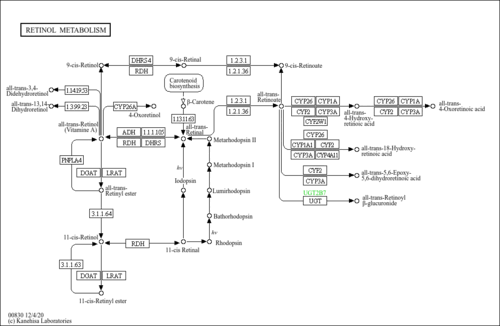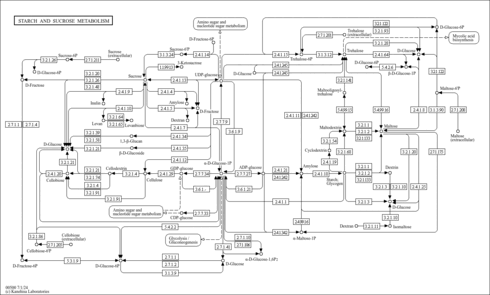| Disease References | | Glucagon deficiency |
|---|
- Vidnes J, Oyasaeter S: Glucagon deficiency causing severe neonatal hypoglycemia in a patient with normal insulin secretion. Pediatr Res. 1977 Sep;11(9 Pt 1):943-9. [PubMed:904979 ]
| | Beckwith-Wiedemann Syndrome |
|---|
- Martinez y Martinez R, Martinez-Carboney R, Ocampo-Campos R, Rivera H, Gomez Plascencia y Castillo J, Cuevas A, Martin Manrique MC: Wiedemann-Beckwith syndrome: clinical, cytogenetical and radiological observations in 39 new cases. Genet Couns. 1992;3(2):67-76. [PubMed:1642813 ]
| | 3-Hydroxy-3-methylglutaryl-CoA lyase deficiency |
|---|
- Ozand PT, al Aqeel A, Gascon G, Brismar J, Thomas E, Gleispach H: 3-Hydroxy-3-methylglutaryl-coenzyme A (HMG-CoA) lyase deficiency in Saudi Arabia. J Inherit Metab Dis. 1991;14(2):174-88. [PubMed:1886403 ]
- Zschocke J, Penzien JM, Bielen R, Casals N, Aledo R, Pie J, Hoffmann GF, Hegardt FG, Mayatepek E: The diagnosis of mitochondrial HMG-CoA synthase deficiency. J Pediatr. 2002 Jun;140(6):778-80. doi: 10.1067/mpd.2002.123854. [PubMed:12072887 ]
- Santarelli F, Cassanello M, Enea A, Poma F, D'Onofrio V, Guala G, Garrone G, Puccinelli P, Caruso U, Porta F, Spada M: A neonatal case of 3-hydroxy-3-methylglutaric-coenzyme A lyase deficiency. Ital J Pediatr. 2013 May 24;39:33. doi: 10.1186/1824-7288-39-33. [PubMed:23705938 ]
| | Hyperinsulinemic hypoglycemia, familial, 1, HHF1 |
|---|
- Horev Z, Ipp M, Levey P, Daneman D: Familial hyperinsulinism: successful conservative management. J Pediatr. 1991 Nov;119(5):717-20. [PubMed:1941376 ]
- Touati G, Poggi-Travert F, Ogier de Baulny H, Rahier J, Brunelle F, Nihoul-Fekete C, Czernichow P, Saudubray JM: Long-term treatment of persistent hyperinsulinaemic hypoglycaemia of infancy with diazoxide: a retrospective review of 77 cases and analysis of efficacy-predicting criteria. Eur J Pediatr. 1998 Aug;157(8):628-33. [PubMed:9727845 ]
| | Long-chain Fatty Acids, Defect in Transport of |
|---|
- Treem WR, Stanley CA, Finegold DN, Hale DE, Coates PM: Primary carnitine deficiency due to a failure of carnitine transport in kidney, muscle, and fibroblasts. N Engl J Med. 1988 Nov 17;319(20):1331-6. doi: 10.1056/NEJM198811173192006. [PubMed:3185635 ]
| | Carnitine transporter defect; primary systemic carnitine deficiency |
|---|
- Treem WR, Stanley CA, Finegold DN, Hale DE, Coates PM: Primary carnitine deficiency due to a failure of carnitine transport in kidney, muscle, and fibroblasts. N Engl J Med. 1988 Nov 17;319(20):1331-6. doi: 10.1056/NEJM198811173192006. [PubMed:3185635 ]
| | Fructose-1,6-diphosphatase deficiency |
|---|
- Baker L, Winegrad AI: Fasting hypoglycaemia and metabolic acidosis associated with deficiency of hepatic fructose-1,6-diphosphatase activity. Lancet. 1970 Jul 4;2(7662):13-6. [PubMed:4193749 ]
- Pagliara AS, Karl IE, Keating JP, Brown BI, Kipnis DM: Hepatic fructose-1,6-diphosphatase deficiency. A cause of lactic acidosis and hypoglycemia in infancy. J Clin Invest. 1972 Aug;51(8):2115-23. doi: 10.1172/JCI107018. [PubMed:4341015 ]
| | Leigh's syndrome, subacute necrotizing encephalopathy, SNE |
|---|
- Hommes FA, Polman HA, Reerink JD: Leigh's encephalomyelopathy: an inborn error of gluconeogenesis. Arch Dis Child. 1968 Aug;43(230):423-6. [PubMed:4873809 ]
| | Proprotein Convertase 1/3 Deficiency |
|---|
- O'Rahilly S, Gray H, Humphreys PJ, Krook A, Polonsky KS, White A, Gibson S, Taylor K, Carr C: Brief report: impaired processing of prohormones associated with abnormalities of glucose homeostasis and adrenal function. N Engl J Med. 1995 Nov 23;333(21):1386-90. doi: 10.1056/NEJM199511233332104. [PubMed:7477119 ]
| | Diabetes and Deafness, Maternally Inherited |
|---|
- Velho G, Byrne MM, Clement K, Sturis J, Pueyo ME, Blanche H, Vionnet N, Fiet J, Passa P, Robert JJ, Polonsky KS, Froguel P: Clinical phenotypes, insulin secretion, and insulin sensitivity in kindreds with maternally inherited diabetes and deafness due to mitochondrial tRNALeu(UUR) gene mutation. Diabetes. 1996 Apr;45(4):478-87. [PubMed:8603770 ]
| | 3-Hydroxy-3-Methylglutaryl-CoA Synthase Deficiency |
|---|
- Thompson GN, Hsu BY, Pitt JJ, Treacy E, Stanley CA: Fasting hypoketotic coma in a child with deficiency of mitochondrial 3-hydroxy-3-methylglutaryl-CoA synthase. N Engl J Med. 1997 Oct 23;337(17):1203-7. doi: 10.1056/NEJM199710233371704. [PubMed:9337379 ]
- Morris AA, Lascelles CV, Olpin SE, Lake BD, Leonard JV, Quant PA: Hepatic mitochondrial 3-hydroxy-3-methylglutaryl-coenzyme a synthase deficiency. Pediatr Res. 1998 Sep;44(3):392-6. doi: 10.1203/00006450-199809000-00021. [PubMed:9727719 ]
- Conboy E, Vairo F, Schultz M, Agre K, Ridsdale R, Deyle D, Oglesbee D, Gavrilov D, Klee EW, Lanpher B: Mitochondrial 3-Hydroxy-3-Methylglutaryl-CoA Synthase Deficiency: Unique Presenting Laboratory Values and a Review of Biochemical and Clinical Features. JIMD Rep. 2017 Oct 14. doi: 10.1007/8904_2017_59. [PubMed:29030856 ]
| | Primary hypomagnesemia |
|---|
- Jin-no Y, Kamiya Y, Okada M, Hirako M, Takada N, Kawaguchi M: Primary hypomagnesemia caused by isolated magnesium malabsorption: atypical case in adult. Intern Med. 1999 Mar;38(3):261-5. [PubMed:10337938 ]
| | Leptin Deficiency or Dysfunction |
|---|
- Farooqi IS, Jebb SA, Langmack G, Lawrence E, Cheetham CH, Prentice AM, Hughes IA, McCamish MA, O'Rahilly S: Effects of recombinant leptin therapy in a child with congenital leptin deficiency. N Engl J Med. 1999 Sep 16;341(12):879-84. doi: 10.1056/NEJM199909163411204. [PubMed:10486419 ]
| | 21-Hydroxylase deficiency |
|---|
- Warinner SA, Zimmerman D, Thompson GB, Grant CS: Study of three patients with congenital adrenal hyperplasia treated by bilateral adrenalectomy. World J Surg. 2000 Nov;24(11):1347-52. [PubMed:11038205 ]
| | 3-Hydroxyacyl-CoA dehydrogenase deficiency |
|---|
- Hsu BY, Kelly A, Thornton PS, Greenberg CR, Dilling LA, Stanley CA: Protein-sensitive and fasting hypoglycemia in children with the hyperinsulinism/hyperammonemia syndrome. J Pediatr. 2001 Mar;138(3):383-9. doi: 10.1067/mpd.2001.111818. [PubMed:11241047 ]
- Clayton PT, Eaton S, Aynsley-Green A, Edginton M, Hussain K, Krywawych S, Datta V, Malingre HE, Berger R, van den Berg IE: Hyperinsulinism in short-chain L-3-hydroxyacyl-CoA dehydrogenase deficiency reveals the importance of beta-oxidation in insulin secretion. J Clin Invest. 2001 Aug;108(3):457-65. [PubMed:11489939 ]
- Molven A, Matre GE, Duran M, Wanders RJ, Rishaug U, Njolstad PR, Jellum E, Sovik O: Familial hyperinsulinemic hypoglycemia caused by a defect in the SCHAD enzyme of mitochondrial fatty acid oxidation. Diabetes. 2004 Jan;53(1):221-7. [PubMed:14693719 ]
- Popa FI, Perlini S, Teofoli F, Degani D, Funghini S, La Marca G, Rinaldo P, Vincenzi M, Antoniazzi F, Boner A, Camilot M: 3-hydroxyacyl-coenzyme a dehydrogenase deficiency: identification of a new mutation causing hyperinsulinemic hypoketotic hypoglycemia, altered organic acids and acylcarnitines concentrations. JIMD Rep. 2012;2:71-7. doi: 10.1007/8904_2011_50. Epub 2011 Sep 6. [PubMed:23430856 ]
| | Carnitine palmitoyltransferase I deficiency |
|---|
- Olpin SE, Allen J, Bonham JR, Clark S, Clayton PT, Calvin J, Downing M, Ives K, Jones S, Manning NJ, Pollitt RJ, Standing SJ, Tanner MS: Features of carnitine palmitoyltransferase type I deficiency. J Inherit Metab Dis. 2001 Feb;24(1):35-42. [PubMed:11286380 ]
| | Acute myelogenous leukemia |
|---|
- Tatidis L, Vitols S, Gruber A, Paul C, Axelson M: Cholesterol catabolism in patients with acute myelogenous leukemia and hypocholesterolemia: suppressed levels of a circulating marker for bile acid synthesis. Cancer Lett. 2001 Sep 20;170(2):169-75. [PubMed:11463495 ]
| | Short-chain L-3-hydroxyacyl-CoA dehydrogenase deficiency |
|---|
- Clayton PT, Eaton S, Aynsley-Green A, Edginton M, Hussain K, Krywawych S, Datta V, Malingre HE, Berger R, van den Berg IE: Hyperinsulinism in short-chain L-3-hydroxyacyl-CoA dehydrogenase deficiency reveals the importance of beta-oxidation in insulin secretion. J Clin Invest. 2001 Aug;108(3):457-65. [PubMed:11489939 ]
| | Mitochondrial trifunctional protein deficiency |
|---|
- den Boer ME, Dionisi-Vici C, Chakrapani A, van Thuijl AO, Wanders RJ, Wijburg FA: Mitochondrial trifunctional protein deficiency: a severe fatty acid oxidation disorder with cardiac and neurologic involvement. J Pediatr. 2003 Jun;142(6):684-9. doi: 10.1067/mpd.2003.231. [PubMed:12838198 ]
| | Hypoglycemia, familial neonatal |
|---|
- COCHRANE WA, PAYNE WW, SIMPKISS MJ, WOOLF LI: Familial hypoglycemia precipitated by amino acids. J Clin Invest. 1956 Apr;35(4):411-22. doi: 10.1172/JCI103292. [PubMed:13306783 ]
| | Hyperlipoproteinemia |
|---|
- Sinha S, Misra A, Kumar V, Jagannathan NR, Bal CS, Pandey RM, Singhania R, Deepak: Proton magnetic resonance spectroscopy and single photon emission computed tomography study of the brain in asymptomatic young hyperlipidaemic Asian Indians in North India show early abnormalities. Clin Endocrinol (Oxf). 2004 Aug;61(2):182-9. [PubMed:15272912 ]
| | 2-Methyl-3-hydroxybutyryl-CoA dehydrogenase deficiency |
|---|
- Perez-Cerda C, Garcia-Villoria J, Ofman R, Sala PR, Merinero B, Ramos J, Garcia-Silva MT, Beseler B, Dalmau J, Wanders RJ, Ugarte M, Ribes A: 2-Methyl-3-hydroxybutyryl-CoA dehydrogenase (MHBD) deficiency: an X-linked inborn error of isoleucine metabolism that may mimic a mitochondrial disease. Pediatr Res. 2005 Sep;58(3):488-91. [PubMed:16148061 ]
| | Growth hormone deficiency |
|---|
- Darzy KH, Murray RD, Gleeson HK, Pezzoli SS, Thorner MO, Shalet SM: The impact of short-term fasting on the dynamics of 24-hour growth hormone (GH) secretion in patients with severe radiation-induced GH deficiency. J Clin Endocrinol Metab. 2006 Mar;91(3):987-94. Epub 2005 Dec 29. [PubMed:16384844 ]
| | Adrenal insufficiency, congenital, with 46,XY sex reversal, partial or complete |
|---|
- Kim CJ, Lin L, Huang N, Quigley CA, AvRuskin TW, Achermann JC, Miller WL: Severe combined adrenal and gonadal deficiency caused by novel mutations in the cholesterol side chain cleavage enzyme, P450scc. J Clin Endocrinol Metab. 2008 Mar;93(3):696-702. doi: 10.1210/jc.2007-2330. Epub 2008 Jan 8. [PubMed:18182448 ]
| | Maturity onset diabetes of the young, type 2 |
|---|
- Estalella I, Garcia-Gimeno MA, Marina A, Castano L, Sanz P: Biochemical characterization of novel glucokinase mutations isolated from Spanish maturity-onset diabetes of the young (MODY2) patients. J Hum Genet. 2008;53(5):460-6. doi: 10.1007/s10038-008-0271-5. Epub 2008 Mar 6. [PubMed:18322640 ]
| | Schizophrenia |
|---|
- Xuan J, Pan G, Qiu Y, Yang L, Su M, Liu Y, Chen J, Feng G, Fang Y, Jia W, Xing Q, He L: Metabolomic profiling to identify potential serum biomarkers for schizophrenia and risperidone action. J Proteome Res. 2011 Dec 2;10(12):5433-43. doi: 10.1021/pr2006796. Epub 2011 Nov 8. [PubMed:22007635 ]
- Cai HL, Li HD, Yan XZ, Sun B, Zhang Q, Yan M, Zhang WY, Jiang P, Zhu RH, Liu YP, Fang PF, Xu P, Yuan HY, Zhang XH, Hu L, Yang W, Ye HS: Metabolomic analysis of biochemical changes in the plasma and urine of first-episode neuroleptic-naive schizophrenia patients after treatment with risperidone. J Proteome Res. 2012 Aug 3;11(8):4338-50. doi: 10.1021/pr300459d. Epub 2012 Jul 26. [PubMed:22800120 ]
- Yang J, Chen T, Sun L, Zhao Z, Qi X, Zhou K, Cao Y, Wang X, Qiu Y, Su M, Zhao A, Wang P, Yang P, Wu J, Feng G, He L, Jia W, Wan C: Potential metabolite markers of schizophrenia. Mol Psychiatry. 2013 Jan;18(1):67-78. doi: 10.1038/mp.2011.131. Epub 2011 Oct 25. [PubMed:22024767 ]
| | Early preeclampsia |
|---|
- Bahado-Singh RO, Akolekar R, Mandal R, Dong E, Xia J, Kruger M, Wishart DS, Nicolaides K: Metabolomics and first-trimester prediction of early-onset preeclampsia. J Matern Fetal Neonatal Med. 2012 Oct;25(10):1840-7. doi: 10.3109/14767058.2012.680254. Epub 2012 Apr 28. [PubMed:22494326 ]
| | Pregnancy |
|---|
- Bahado-Singh RO, Akolekar R, Mandal R, Dong E, Xia J, Kruger M, Wishart DS, Nicolaides K: Metabolomics and first-trimester prediction of early-onset preeclampsia. J Matern Fetal Neonatal Med. 2012 Oct;25(10):1840-7. doi: 10.3109/14767058.2012.680254. Epub 2012 Apr 28. [PubMed:22494326 ]
- Bahado-Singh RO, Akolekar R, Mandal R, Dong E, Xia J, Kruger M, Wishart DS, Nicolaides K: First-trimester metabolomic detection of late-onset preeclampsia. Am J Obstet Gynecol. 2013 Jan;208(1):58.e1-7. doi: 10.1016/j.ajog.2012.11.003. Epub 2012 Nov 13. [PubMed:23159745 ]
- Bahado-Singh RO, Akolekar R, Mandal R, Dong E, Xia J, Kruger M, Wishart DS, Nicolaides K: Metabolomic analysis for first-trimester Down syndrome prediction. Am J Obstet Gynecol. 2013 May;208(5):371.e1-8. doi: 10.1016/j.ajog.2012.12.035. Epub 2013 Jan 8. [PubMed:23313728 ]
- Bahado-Singh RO, Akolekar R, Chelliah A, Mandal R, Dong E, Kruger M, Wishart DS, Nicolaides K: Metabolomic analysis for first-trimester trisomy 18 detection. Am J Obstet Gynecol. 2013 Jul;209(1):65.e1-9. doi: 10.1016/j.ajog.2013.03.028. Epub 2013 Mar 25. [PubMed:23535240 ]
- Bahado-Singh RO, Ertl R, Mandal R, Bjorndahl TC, Syngelaki A, Han B, Dong E, Liu PB, Alpay-Savasan Z, Wishart DS, Nicolaides KH: Metabolomic prediction of fetal congenital heart defect in the first trimester. Am J Obstet Gynecol. 2014 Sep;211(3):240.e1-240.e14. doi: 10.1016/j.ajog.2014.03.056. Epub 2014 Apr 1. [PubMed:24704061 ]
| | Late-onset preeclampsia |
|---|
- Bahado-Singh RO, Akolekar R, Mandal R, Dong E, Xia J, Kruger M, Wishart DS, Nicolaides K: First-trimester metabolomic detection of late-onset preeclampsia. Am J Obstet Gynecol. 2013 Jan;208(1):58.e1-7. doi: 10.1016/j.ajog.2012.11.003. Epub 2012 Nov 13. [PubMed:23159745 ]
| | Adrenal hyperplasia, congenital, due to 3-beta-hydroxysteroid dehydrogenase 2 deficiency |
|---|
- Benkert AR, Young M, Robinson D, Hendrickson C, Lee PA, Strauss KA: Severe Salt-Losing 3beta-Hydroxysteroid Dehydrogenase Deficiency: Treatment and Outcomes of HSD3B2 c.35G>A Homozygotes. J Clin Endocrinol Metab. 2015 Aug;100(8):E1105-15. doi: 10.1210/jc.2015-2098. Epub 2015 Jun 16. [PubMed:26079780 ]
| | Infantile Liver Failure Syndrome 2 |
|---|
- Staufner C, Haack TB, Kopke MG, Straub BK, Kolker S, Thiel C, Freisinger P, Baric I, McKiernan PJ, Dikow N, Harting I, Beisse F, Burgard P, Kotzaeridou U, Lenz D, Kuhr J, Himbert U, Taylor RW, Distelmaier F, Vockley J, Ghaloul-Gonzalez L, Ozolek JA, Zschocke J, Kuster A, Dick A, Das AM, Wieland T, Terrile C, Strom TM, Meitinger T, Prokisch H, Hoffmann GF: Recurrent acute liver failure due to NBAS deficiency: phenotypic spectrum, disease mechanisms, and therapeutic concepts. J Inherit Metab Dis. 2016 Jan;39(1):3-16. doi: 10.1007/s10545-015-9896-7. Epub 2015 Nov 5. [PubMed:26541327 ]
| | Metabolic encephalomyopathic crises, recurrent, with rhabdomyolysis, cardiac arrhythmias, and neurodegeneration |
|---|
- Lalani SR, Liu P, Rosenfeld JA, Watkin LB, Chiang T, Leduc MS, Zhu W, Ding Y, Pan S, Vetrini F, Miyake CY, Shinawi M, Gambin T, Eldomery MK, Akdemir ZH, Emrick L, Wilnai Y, Schelley S, Koenig MK, Memon N, Farach LS, Coe BP, Azamian M, Hernandez P, Zapata G, Jhangiani SN, Muzny DM, Lotze T, Clark G, Wilfong A, Northrup H, Adesina A, Bacino CA, Scaglia F, Bonnen PE, Crosson J, Duis J, Maegawa GH, Coman D, Inwood A, McGill J, Boerwinkle E, Graham B, Beaudet A, Eng CM, Hanchard NA, Xia F, Orange JS, Gibbs RA, Lupski JR, Yang Y: Recurrent Muscle Weakness with Rhabdomyolysis, Metabolic Crises, and Cardiac Arrhythmia Due to Bi-allelic TANGO2 Mutations. Am J Hum Genet. 2016 Feb 4;98(2):347-57. doi: 10.1016/j.ajhg.2015.12.008. Epub 2016 Jan 21. [PubMed:26805781 ]
| | Donohue Syndrome |
|---|
- Nijim Y, Awni Y, Adawi A, Bowirrat A: Classic Case Report of Donohue Syndrome (Leprechaunism; OMIM *246200): The Impact of Consanguineous Mating. Medicine (Baltimore). 2016 Feb;95(6):e2710. doi: 10.1097/MD.0000000000002710. [PubMed:26871809 ]
| | Phosphoenolpyruvate Carboxykinase Deficiency 1, Cytosolic |
|---|
- Santra S, Cameron JM, Shyr C, Zhang L, Drogemoller B, Ross CJ, Wasserman WW, Wevers RA, Rodenburg RJ, Gupte G, Preece MA, van Karnebeek CD: Cytosolic phosphoenolpyruvate carboxykinase deficiency presenting with acute liver failure following gastroenteritis. Mol Genet Metab. 2016 May;118(1):21-7. doi: 10.1016/j.ymgme.2016.03.001. Epub 2016 Mar 4. [PubMed:26971250 ]
- Vieira P, Cameron J, Rahikkala E, Keski-Filppula R, Zhang LH, Santra S, Matthews A, Myllynen P, Nuutinen M, Moilanen JS, Rodenburg RJ, Rolfs A, Uusimaa J, van Karnebeek CDM: Novel homozygous PCK1 mutation causing cytosolic phosphoenolpyruvate carboxykinase deficiency presenting as childhood hypoglycemia, an abnormal pattern of urine metabolites and liver dysfunction. Mol Genet Metab. 2017 Apr;120(4):337-341. doi: 10.1016/j.ymgme.2017.02.003. Epub 2017 Feb 6. [PubMed:28216384 ]
| | Sepsis |
|---|
- Wernly B, Lichtenauer M, Hoppe UC, Jung C: Hyperglycemia in septic patients: an essential stress survival response in all, a robust marker for risk stratification in some, to be messed with in none. J Thorac Dis. 2016 Jul;8(7):E621-4. doi: 10.21037/jtd.2016.05.24. [PubMed:27501420 ]
| | Lipodystrophy |
|---|
- Akinci G, Topaloglu H, Demir T, Danyeli AE, Talim B, Keskin FE, Kadioglu P, Talip E, Altay C, Yaylali GF, Bilen H, Nur B, Demir L, Onay H, Akinci B: Clinical spectra of neuromuscular manifestations in patients with lipodystrophy: A multicenter study. Neuromuscul Disord. 2017 Oct;27(10):923-930. doi: 10.1016/j.nmd.2017.05.015. Epub 2017 Jun 1. [PubMed:28754454 ]
| | Lipodystrophy, Congenital Generalized |
|---|
- Akinci G, Topaloglu H, Demir T, Danyeli AE, Talim B, Keskin FE, Kadioglu P, Talip E, Altay C, Yaylali GF, Bilen H, Nur B, Demir L, Onay H, Akinci B: Clinical spectra of neuromuscular manifestations in patients with lipodystrophy: A multicenter study. Neuromuscul Disord. 2017 Oct;27(10):923-930. doi: 10.1016/j.nmd.2017.05.015. Epub 2017 Jun 1. [PubMed:28754454 ]
| | Partial lipodystrophy |
|---|
- Akinci G, Topaloglu H, Demir T, Danyeli AE, Talim B, Keskin FE, Kadioglu P, Talip E, Altay C, Yaylali GF, Bilen H, Nur B, Demir L, Onay H, Akinci B: Clinical spectra of neuromuscular manifestations in patients with lipodystrophy: A multicenter study. Neuromuscul Disord. 2017 Oct;27(10):923-930. doi: 10.1016/j.nmd.2017.05.015. Epub 2017 Jun 1. [PubMed:28754454 ]
| | Familial partial lipodystrophy |
|---|
- Akinci G, Topaloglu H, Demir T, Danyeli AE, Talim B, Keskin FE, Kadioglu P, Talip E, Altay C, Yaylali GF, Bilen H, Nur B, Demir L, Onay H, Akinci B: Clinical spectra of neuromuscular manifestations in patients with lipodystrophy: A multicenter study. Neuromuscul Disord. 2017 Oct;27(10):923-930. doi: 10.1016/j.nmd.2017.05.015. Epub 2017 Jun 1. [PubMed:28754454 ]
| | 3-Methyl-crotonyl-glycinuria |
|---|
- G.Frauendienst-Egger, Friedrich K. Trefz (2017). MetaGene: Metabolic & Genetic Information Center (MIC: http://www.metagene.de). METAGENE consortium.
| | Addison's Disease |
|---|
- G.Frauendienst-Egger, Friedrich K. Trefz (2017). MetaGene: Metabolic & Genetic Information Center (MIC: http://www.metagene.de). METAGENE consortium.
| | Fanconi Bickel syndrome |
|---|
- Nirupama Gupta, Bimota Nambam, David A. Weinstein, and Lawrence R. Shoemaker (2016). Late Diagnosis of Fanconi-Bickel Syndrome: Challenges With the Diagnosis and Literature Review . Journal of Inborn Errors of Metabolism and Screening.
| | Wolcott-Rallison syndrome |
|---|
- Can Thi Bich Ngoc, Vu Chi Dung, Sarah Flanagan and Sian Ellard (2013). Neonatal diabetes in Wolcott-Rallison syndrome: a case report. International Journal of Pediatric Endocrinology.
| | Alzheimer's disease |
|---|
- Redjems-Bennani N, Jeandel C, Lefebvre E, Blain H, Vidailhet M, Gueant JL: Abnormal substrate levels that depend upon mitochondrial function in cerebrospinal fluid from Alzheimer patients. Gerontology. 1998;44(5):300-4. [PubMed:9693263 ]
| | Glucose transporter type 1 deficiency syndrome |
|---|
- Wang D, Pascual JM, Yang H, Engelstad K, Jhung S, Sun RP, De Vivo DC: Glut-1 deficiency syndrome: clinical, genetic, and therapeutic aspects. Ann Neurol. 2005 Jan;57(1):111-8. [PubMed:15622525 ]
- Koy A, Assmann B, Klepper J, Mayatepek E: Glucose transporter type 1 deficiency syndrome with carbohydrate-responsive symptoms but without epilepsy. Dev Med Child Neurol. 2011 Dec;53(12):1154-6. doi: 10.1111/j.1469-8749.2011.04082.x. Epub 2011 Aug 12. [PubMed:21838819 ]
| | Irritable bowel syndrome |
|---|
- Ponnusamy K, Choi JN, Kim J, Lee SY, Lee CH: Microbial community and metabolomic comparison of irritable bowel syndrome faeces. J Med Microbiol. 2011 Jun;60(Pt 6):817-27. doi: 10.1099/jmm.0.028126-0. Epub 2011 Feb 17. [PubMed:21330412 ]
- Le Gall G, Noor SO, Ridgway K, Scovell L, Jamieson C, Johnson IT, Colquhoun IJ, Kemsley EK, Narbad A: Metabolomics of fecal extracts detects altered metabolic activity of gut microbiota in ulcerative colitis and irritable bowel syndrome. J Proteome Res. 2011 Sep 2;10(9):4208-18. doi: 10.1021/pr2003598. Epub 2011 Aug 8. [PubMed:21761941 ]
- Hong YS, Hong KS, Park MH, Ahn YT, Lee JH, Huh CS, Lee J, Kim IK, Hwang GS, Kim JS: Metabonomic understanding of probiotic effects in humans with irritable bowel syndrome. J Clin Gastroenterol. 2011 May-Jun;45(5):415-25. doi: 10.1097/MCG.0b013e318207f76c. [PubMed:21494186 ]
| | Ulcerative colitis |
|---|
- Le Gall G, Noor SO, Ridgway K, Scovell L, Jamieson C, Johnson IT, Colquhoun IJ, Kemsley EK, Narbad A: Metabolomics of fecal extracts detects altered metabolic activity of gut microbiota in ulcerative colitis and irritable bowel syndrome. J Proteome Res. 2011 Sep 2;10(9):4208-18. doi: 10.1021/pr2003598. Epub 2011 Aug 8. [PubMed:21761941 ]
- Azario I, Pievani A, Del Priore F, Antolini L, Santi L, Corsi A, Cardinale L, Sawamoto K, Kubaski F, Gentner B, Bernardo ME, Valsecchi MG, Riminucci M, Tomatsu S, Aiuti A, Biondi A, Serafini M: Neonatal umbilical cord blood transplantation halts skeletal disease progression in the murine model of MPS-I. Sci Rep. 2017 Aug 25;7(1):9473. doi: 10.1038/s41598-017-09958-9. [PubMed:28842642 ]
| | Gout |
|---|
- Shao T, Shao L, Li H, Xie Z, He Z, Wen C: Combined Signature of the Fecal Microbiome and Metabolome in Patients with Gout. Front Microbiol. 2017 Feb 21;8:268. doi: 10.3389/fmicb.2017.00268. eCollection 2017. [PubMed:28270806 ]
| | Rheumatoid arthritis |
|---|
- Tie-juan ShaoZhi-xing HeZhi-jun XieHai-chang LiMei-jiao WangCheng-ping Wen. Characterization of ankylosing spondylitis and rheumatoid arthritis using 1H NMR-based metabolomics of human fecal extracts. Metabolomics. April 2016, 12:70 [Link]
| | Colorectal cancer |
|---|
- Goedert JJ, Sampson JN, Moore SC, Xiao Q, Xiong X, Hayes RB, Ahn J, Shi J, Sinha R: Fecal metabolomics: assay performance and association with colorectal cancer. Carcinogenesis. 2014 Sep;35(9):2089-96. doi: 10.1093/carcin/bgu131. Epub 2014 Jul 18. [PubMed:25037050 ]
- Sinha R, Ahn J, Sampson JN, Shi J, Yu G, Xiong X, Hayes RB, Goedert JJ: Fecal Microbiota, Fecal Metabolome, and Colorectal Cancer Interrelations. PLoS One. 2016 Mar 25;11(3):e0152126. doi: 10.1371/journal.pone.0152126. eCollection 2016. [PubMed:27015276 ]
- Lin Y, Ma C, Liu C, Wang Z, Yang J, Liu X, Shen Z, Wu R: NMR-based fecal metabolomics fingerprinting as predictors of earlier diagnosis in patients with colorectal cancer. Oncotarget. 2016 May 17;7(20):29454-64. doi: 10.18632/oncotarget.8762. [PubMed:27107423 ]
| | Diverticular disease |
|---|
- Tursi A, Mastromarino P, Capobianco D, Elisei W, Miccheli A, Capuani G, Tomassini A, Campagna G, Picchio M, Giorgetti G, Fabiocchi F, Brandimarte G: Assessment of Fecal Microbiota and Fecal Metabolome in Symptomatic Uncomplicated Diverticular Disease of the Colon. J Clin Gastroenterol. 2016 Oct;50 Suppl 1:S9-S12. doi: 10.1097/MCG.0000000000000626. [PubMed:27622378 ]
| | Diabetes mellitus type 2 |
|---|
- Bales JR, Higham DP, Howe I, Nicholson JK, Sadler PJ: Use of high-resolution proton nuclear magnetic resonance spectroscopy for rapid multi-component analysis of urine. Clin Chem. 1984 Mar;30(3):426-32. [PubMed:6321058 ]
- Hoppel CL, Genuth SM: Urinary excretion of acetylcarnitine during human diabetic and fasting ketosis. Am J Physiol. 1982 Aug;243(2):E168-72. [PubMed:6810706 ]
- NA (1999). World Health Organisation Department of Noncommunicable Disease Surveillance (1999). "Definition, Diagnosis and Classification of Diabetes Mellitus and its Complications". WHO.
| | Diabetes mellitus type 1 |
|---|
- Lorena Ivona ŞTEFAN, Alina NICOLESCU, Simona POPA, Maria MOŢA, Eugenia KOVACS and Calin DELEANU (2010). Lorena Ivona ŞTEFAN, Alina NICOLESCU, Simona POPA, Maria MOŢA, Eugenia KOVACS and Calin DELEANU. 1H-NMR URINE METABOLIC PROFILING IN TYPE 1 DIABETES MELLITUS. Rev. Roum. Chim., 2010, 55(11-12), 1033-1037 . Rev. Roum. Chim.
| | Eosinophilic esophagitis |
|---|
- Slae, M., Huynh, H., Wishart, D.S. (2014). Analysis of 30 normal pediatric urine samples via NMR spectroscopy (unpublished work). NA.
|
|
|---|



